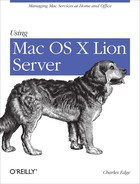A podcast is a file containing video and/or audio that people view over a network connection. Podcast Producer is Apple’s solution for recording, distributing, and accessing podcasts. Podcast Producer can be linked to iTunes, allowing users a one-stop shop for accessing rich media. Often used in schools and corporate training, Podcast Producer is one of the more elegant solutions for podcasting, using tools built into Mac OS X to make it easier than ever to capture video (which includes screen captures and audio-only podcasts) and distribute the content to users.
While Podcast Producer makes it easier than ever to work with video, it is one of the more complicated services built into Mac OS X Server. Leveraging directory services, web services, grid computing and often mass storage, Podcast Producer has a lot of moving parts. If any part isn’t firing properly, then the whole solution will not function.
There are two ways to set up Podcast Producer. The first is a simple workflow where all podcasts are posted to a website. Once posted, podcasts can be viewed on the website, the feed can be aggregated using RSS (we’ll look a bit more at RSS later in this chapter), or the podcast can be subscribed to and viewed from within iTunes. The second setup for Podcast Producer has all the same options, but comes with few by default. This is a more manual configuration, but allows you to do practically anything you desire (e.g.,, watermarking content, merging clips with introductory videos, or layering Keynote presentations or additional audio tracks to the workflow).
Given that little has changed with the second setup since Snow Leopard and that our focus here is on ease of use, we will focus on the first style of configuration in this chapter. Using Podcast Producer in this fashion, you can be up and running in minutes, hosting your own podcast and sharing it with friends via iTunes.
This style of Podcast Producer works by using a client application, Podcast Publisher, to create these rich media files. Once created, the files are uploaded to the server for processing. The processing can include simple items, such as watermarking a file (or putting a logo in each frame of a video file), adding scenes to the front and back of a file to show information about the file (e.g., title, copyright, and author), and publishing to a site or RSS feed. Apple makes all this seem easy, but it’s actually pretty difficult to do under the hood (which luckily we don’t need to know anything about).
Before you get started with Podcast Producer, there are a few things to take care of. In this example, we will use a standard implementation of Podcast Producer. The tool is capable of much more, but we will focus on getting your server up and running so you can extend what it does at a later time. Podcast Producer has a number of prerequisites though. These include web services, DNS, Directory Services, IP addresses, and ports to forward (if the podcast will be accessible from outside of the network).
The IP address of the server should be static. This is true for most services, but dynamic IP addresses (e.g., DHCP) on a Podcast Producer server will cause the services within the server to become unresponsive. Not only will podcasts be inaccessible because users are looking at the wrong IP address for them, but in addition, the service will fail to function, even if you repoint users at a different IP address. DNS and the hostnames that make up a properly resolvable server are important for the same reason. These two are covered thoroughly in Chapters 1 and 2, so if you have any problems with them, go back and review those chapters.
Each Podcast Producer will need to run a shared directory service, such as Open Directory. The directory service is important, but if you do not yet have a functioning Open Directory, you will be prompted to set one up during the deployment of Podcast Producer. This eases the deployment of Podcast Producer and ensures you will have functional usernames and passwords to access content, create content, and authenticate Podcast Producer services to one another.
The Podcast Producer server will need to be running the web services. The web services supply the portal that users visit to see published podcasts. For more information on enabling the web service and configuring a site, see Chapter 5. If the server will be accessible outside of your network, then ports must be opened on the firewall. For more on the web service portion of Podcast Producer, also see Chapter 5. In addition to the web services, though, the ports 8170 and 8171 will need to be opened for the Podcast Capture and podcast command-line tools, if those are to connect to the server remotely.
